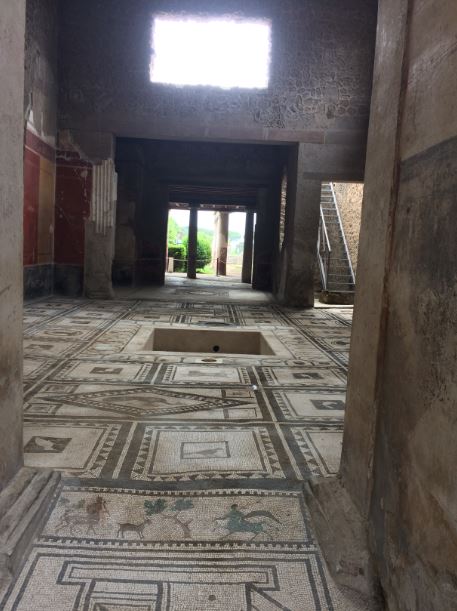 Thermal Mass, An Energy Efficient Home’s Best Friend
Thermal Mass, An Energy Efficient Home’s Best Friend
Would you like mother nature to keep your home’s inside temperature in the sweet spot every day of the year. It will cost you nothing, she never takes a day off, she delivers the same quality service regardless of whatever else may be happening and she doesn’t put her prices up every year.
Does that sound too good to be true? Well it isn’t and it’s not a new science it’s been well understood and utilised for thousands of years.
The city gates in Naples was built from massive amounts of rock, as shown in the first picture, which has significant thermal stability. And just down the road near a volcano, imaging how thermally comfortable the homes of Herculean, picture 2, would have been, even though, like Pompeii, they had other issues to contend with.
So, … what is thermal mass and how does it stabilize the ambient temperature of a home? Wikipedia says that “thermal mass is a property of the mass of a building which enables it to store heat, providing “inertia” against temperature fluctuations. It is sometimes known as the thermal flywheel effect”.
The temperatures you will experience at a Beachside Resort are significantly more comfortable than the temperatures you will experience in the middle of a desert. Unless your Beachside Resort is in Antarctica, living closer to the beach is thermally more comfortable than living further away.
The reason living closer to the beach is more comfortable is because the temperatures are more stabilized with less extreme fluctuations. This is called the Maritime effect and temperatures stay within close rages because of the properties of water.
The more water, the less temperature variations are generally experienced by those who live nearby. Not everywhere in the ocean is as deep as the Marianas Trench however the ocean is huge and it has huge thermal inertia. That is, it takes a lot of energy to change the temperature of the sea either up or down and this does not happen readily.
Apart from the added advantage of living beachside which also includes the Maritime Climate of gulf streams of warm air, the ambient temperature of the air near coastal locations is more comfortable because it is regulated by the stable temperature of the sea. Because of this wonderful law, which we refer to as the second law of thermodynamics, materials that are hot give off heat in a cooler environment and materials that are cool absorb heat in a warmer environment.
The oceans are huge and are absorbing or dissipating heat to stabilize the temperatures of any materials they are in contact with. Now you may not be able to fit the Pacific Ocean in your lounge room, and even if you could, someone would notice if you had taken it, but you can help stabilize the internal temperatures of your home cleverly by arranging building materials with high thermal mass to be strategically located both in and around the building.
 Building materials with high thermal mass include tiles, concrete and bricks. Building materials with low thermal mass include timber and steel. A steel roof can get incredibly hot but it doesn’t store heat because it doesn’t have high thermal mass. A tiled roof however, may not get as hot as a steel roof but it will store heat energy that it will re radiate long after the sun has gone down.
Building materials with high thermal mass include tiles, concrete and bricks. Building materials with low thermal mass include timber and steel. A steel roof can get incredibly hot but it doesn’t store heat because it doesn’t have high thermal mass. A tiled roof however, may not get as hot as a steel roof but it will store heat energy that it will re radiate long after the sun has gone down.
In a heatwave during a hot summer this is exactly what you don’t want.
That’s why building materials with high thermal mass or low thermal mass need to be located appropriately to naturally mitigate extreme ambient temperature fluctuations within the home.
Internal bricks of a home that are cooled during the cool night will absorb heat through the day helping to stabilize the ambient temperature. During cold weather the same bricks, when warmed through the day, will radiate heat which will help stabilize the home’s internal temperature through the night.
The more thermal mass you have the more heat energy can be absorbed and stored.
A home with appropriately located thermal mass should be opened up through the day during the winter time to absorb daytime heat energy and then be closed at night so that the re radiated heat energy is contained to maintain a constant and comfortable temperature within the home.
The #1 best tactic for making your home more energy efficient
(hint: it’s not putting millions of solar panels on your roof) >>>LEARN MORE>>>
That same home would be opened up during the summer nights to allow the cool air to cool the bricks and would be closed during the day so that any rise in ambient temperature was absorbed by the cooler bricks.
During summer, we frequently experience daytime outside temperatures in excess of 40 degrees whilst enjoying temperatures inside our home of less than 23 degrees. It is not uncommon for daytime temperatures in our bedroom, which is located on the eastern side of our home, to still be less than 20 degrees after a hot summer’s day.
Thermal Mass, A Comfortable Home’s Best Friend
John Lynn
suburbanoffgridliving.com
